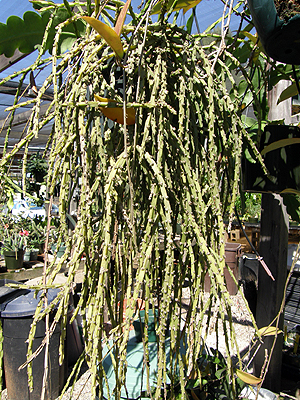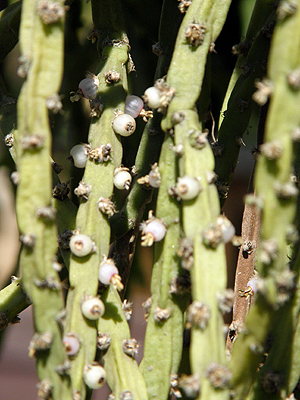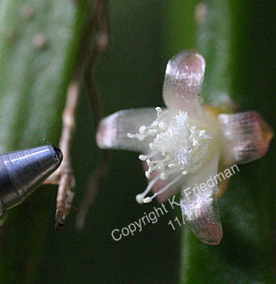Rhipsalis paradoxa var. catenulata Kimn., C&SJ (US) p90
(1992)
Reduced to synonymy under R. pacheco-leonis ssp. catenulata
by B&T Bradleya 13 Rhipsalis paradoxa var. catenulata
Kimn.



Desc from C&SJ (US) p90 (1992)
Differt a var. paradoxa caulibus 3 - 5 - angulatis tenuioribus, podariis
1-3 cm longis, floribus 7-9 mm latis rose is.
- Plant - to 120 cm long or more;
- Stems - at first erect to arching, finally pendent, branching di¬chotomously or, more commonly, verticillately, with clusters of 2 - 6 stems 15-100 cm long or more, 5-7 mm thick, 3-5-angled, the podaria forming alternating, subobtuse, thin, discontinuous ribs 15-25 mm long, 2 - 4 mm high and 1-2 mm thick; epidermis dull, rugose-verrucose, light green to yellowish green;
- Bracteoles - ap¬pressed against stem and areolar wool, widely ovate-truncate, cuspidate, 0.1-1 mm long, ca. 1.5 mm wide, fleshy, pinkish on young stems, the margin greenish white and somewhat translucent, the cusp often reddish;
- Spines - up to 3, flattened-subulate, acute, parallel to stem or appressed, curved or sinuous, 0.5-2 mm long, cream to tan; areolar wool hidden by bracteole on young stems, ca. 1 mm long, cream; flowering areoles sunken in pits 3 - 4 mm wide and 1-1.5 mm deep, the pits rimmed by brownish dry stem-epidermis and filled with radiating areolar hairs.
- Flowers appearing along whole length of stems, single at each areole, bursting through epidermis and remaining with basal half of receptacle bur¬ied in areolar pit, expanded only during daytime, 6-7.5 mm long, opening 7-9 mm wide;
- Receptacle turbinate, ca. 2 mm long and 2.5-3 mm thick, lacking bracteoles and areoles, smooth and shiny, yellowish green, the receptacle tube ca. 0.25 mm long;
- Outer tepals ascending to slightly recurving, ovate, obtuse, 3 - 4 mm long and wide, fleshy, yellowish to yellowish green;
- Inner tepals rotate to recurving, oblong-ovate, obtuse, some¬times also narrowly emarginate, 4-5 mm long, 3 mm wide, shiny, pinkish cream; ovule chamber oblong, less than 1 mm long and wide;
- Stamens ca. 50, in a ring at apex of receptacle, 2~ mm long, cream, the anthers ca. 0.25 mm long, cream;
- Style ca. 3 mm long and 0.75 mm thick, cream, the stigma 3-lobed, the lobes somewhat expand¬ing, broadly ovate, concave on dorsal side, densely covered with white hair-like papillae ca. 0.25 mm long.
- Fruit immersed in stem until shortly before ripening, then rapidly swelling and becoming al-most entirely visible, globose-turbinate, 5 mm long and wide, lacking bracteoles or areoles, dull, whitish, translucent, with a dark magenta margin less than 1 mm wide circling fruit apex at base of the 3 mm long, yellowish, dried perianth.
- Seeds oblong-subreniform, obliquely truncate at hilar end, 1-1.25 mm long, ca. 0.75 mm wide, ca. 0.5 mm thick, minutely pitted, rather shiny, black; hilum slightly sunken, whitish.
BRAZIL: Rio de Janeiro: Sansao, near Lu¬miar, 1976, J. A. Fowlie
s.n., Huntington B.G. 37754 (HNT, holotype; HEID, US, isotypes); Bocerao,
NE of Sao Pedro da Aldeia, 1975, J. A. Fowlie s.n., Huntington B.G. 35995
(HNT, paratype).